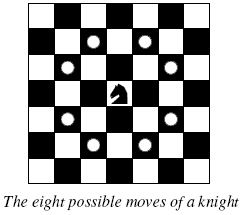A Knight's Journey
| Time Limit: 1000MS | Memory Limit: 65536K | |
| Total Submissions: 27258 | Accepted: 9295 |
Description
 Background
Background
The knight is getting bored of seeing the same black and white squares again and again and has decided to make a journey
around the world. Whenever a knight moves, it is two squares in one direction and one square perpendicular to this. The world of a knight is the chessboard he is living on. Our knight lives on a chessboard that has a smaller area than a regular 8 * 8 board, but it is still rectangular. Can you help this adventurous knight to make travel plans?
Problem
Find a path such that the knight visits every square once. The knight can start and end on any square of the board.
Input
The input begins with a positive integer n in the first line. The following lines contain n test cases. Each test case consists of a single line with two positive integers p and q, such that 1 <= p * q <= 26. This represents a p * q chessboard, where p describes how many different square numbers 1, . . . , p exist, q describes how many different square letters exist. These are the first q letters of the Latin alphabet: A, . . .
Output
The output for every scenario begins with a line containing "Scenario #i:", where i is the number of the scenario starting at 1. Then print a single line containing the lexicographically first path that visits all squares of the chessboard with knight moves followed by an empty line. The path should be given on a single line by concatenating the names of the visited squares. Each square name consists of a capital letter followed by a number.
If no such path exist, you should output impossible on a single line.
If no such path exist, you should output impossible on a single line.
Sample Input
3 1 1 2 3 4 3
Sample Output
Scenario #1: A1 Scenario #2: impossible Scenario #3: A1B3C1A2B4C2A3B1C3A4B2C4
大致题意:给出一个p行q列的国际棋盘,马可以从任意一个格子开始走,问马能否不重复的走完所有的棋盘。如果可以,输出按字典序排列最小的路径。打印路径时,列用大写字母表示(A表示第一列),行用阿拉伯数字表示(从1开始),先输出列,再输出行。
分析:如果马可以不重复的走完所有的棋盘,那么它一定可以走到A1这个格子。所以我们只需从A1这个格子开始搜索,就能保证字典序是小的;除了这个条件,我们还要控制好马每次移动的方向,控制方向时保证字典序最小(即按照下图中格子的序号搜索)。控制好这两个条件,直接从A1开始深搜就行了。

AC代码:
#include<cstdio>
#include<cstring>
#include<algorithm>
using namespace std;
int path[88][88], vis[88][88], p, q, cnt;
bool flag;
int dx[8] = {-1, 1, -2, 2, -2, 2, -1, 1};
int dy[8] = {-2, -2, -1, -1, 1, 1, 2, 2};
bool judge(int x, int y)
{
if(x >= 1 && x <= p && y >= 1 && y <= q && !vis[x][y] && !flag)
return true;
return false;
}
void DFS(int r, int c, int step)
{
path[step][0] = r;
path[step][1] = c;
if(step == p * q)
{
flag = true;
return ;
}
for(int i = 0; i < 8; i++)
{
int nx = r + dx[i];
int ny = c + dy[i];
if(judge(nx,ny))
{
vis[nx][ny] = 1;
DFS(nx,ny,step+1);
vis[nx][ny] = 0;
}
}
}
int main()
{
int i, j, n, cas = 0;
scanf("%d",&n);
while(n--)
{
flag = 0;
scanf("%d%d",&p,&q);
memset(vis,0,sizeof(vis));
vis[1][1] = 1;
DFS(1,1,1);
printf("Scenario #%d:\n",++cas);
if(flag)
{
for(i = 1; i <= p * q; i++)
printf("%c%d",path[i][1] - 1 + 'A',path[i][0]);
}
else
printf("impossible");
printf("\n");
if(n != 0)
printf("\n");
}
return 0;
}





















 523
523

 被折叠的 条评论
为什么被折叠?
被折叠的 条评论
为什么被折叠?








